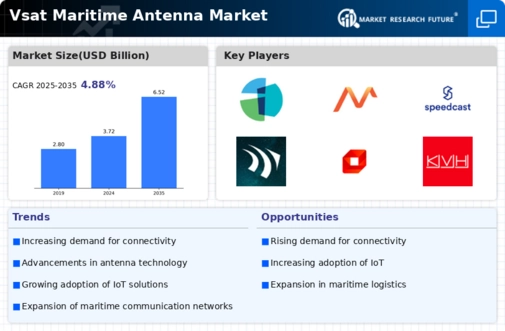Market Growth Projections
The Global Vsat Maritime Antenna Market Industry is poised for substantial growth, with projections indicating a market value of 3.72 USD Billion in 2024 and an anticipated increase to 6.52 USD Billion by 2035. This growth trajectory suggests a robust demand for Vsat technology, driven by factors such as increased maritime trade, regulatory compliance, and technological advancements. The compound annual growth rate (CAGR) of 5.24% from 2025 to 2035 further emphasizes the industry's potential for expansion. These figures reflect a dynamic market landscape, where innovation and investment in maritime communication solutions are likely to flourish.
Expansion of Maritime Trade Activities
The Global Vsat Maritime Antenna Market Industry is significantly influenced by the expansion of maritime trade activities worldwide. As global trade continues to grow, the number of vessels operating in international waters increases, necessitating robust communication systems. The projected market value of 6.52 USD Billion by 2035 underscores the importance of Vsat technology in supporting this growth. Enhanced communication capabilities are crucial for navigation, safety, and operational management, which are vital for the efficiency of maritime logistics. This expansion not only drives demand for Vsat antennas but also encourages innovation in maritime communication solutions.
Regulatory Compliance and Safety Standards
The Global Vsat Maritime Antenna Market Industry is shaped by stringent regulatory compliance and safety standards imposed by maritime authorities. These regulations often mandate the use of advanced communication systems to ensure safety and operational efficiency. As a result, shipping companies are increasingly adopting Vsat technology to meet these requirements. The anticipated compound annual growth rate (CAGR) of 5.24% from 2025 to 2035 reflects the industry's adaptation to evolving regulations. Compliance with safety standards not only enhances operational reliability but also mitigates risks associated with maritime operations, thereby driving the demand for Vsat antennas.
Technological Advancements in Antenna Design
The Global Vsat Maritime Antenna Market Industry benefits from continuous technological advancements in antenna design and functionality. Innovations such as phased array antennas and multi-band capabilities enhance the performance and versatility of Vsat systems. These advancements enable vessels to maintain stable connections even in challenging maritime environments. As the industry evolves, operators are increasingly inclined to invest in cutting-edge technology to improve communication efficiency. This trend is likely to contribute to the market's growth, as enhanced antenna designs facilitate better data transmission and connectivity, which are crucial for modern maritime operations.
Emergence of IoT and Smart Shipping Solutions
The Global Vsat Maritime Antenna Market Industry is witnessing a transformative shift with the emergence of Internet of Things (IoT) and smart shipping solutions. These technologies enable real-time data collection and analysis, enhancing operational efficiency and decision-making processes. The integration of Vsat antennas with IoT devices allows for seamless communication between vessels and shore-based operations. This trend is expected to drive significant growth in the market, as shipping companies seek to leverage data-driven insights to optimize their operations. The increasing adoption of smart shipping solutions indicates a future where Vsat technology plays a pivotal role in maritime innovation.
Increasing Demand for High-Speed Connectivity
The Global Vsat Maritime Antenna Market Industry experiences a surge in demand for high-speed connectivity solutions, driven by the growing need for reliable internet access on vessels. As maritime operations become increasingly digitalized, the requirement for seamless communication and data transfer is paramount. In 2024, the market is projected to reach 3.72 USD Billion, reflecting the industry's response to this demand. Shipowners and operators are investing in advanced Vsat systems to enhance operational efficiency and crew welfare, thereby propelling market growth. This trend indicates a shift towards more sophisticated maritime communication technologies, which are essential for modern shipping operations.





















Leave a Comment